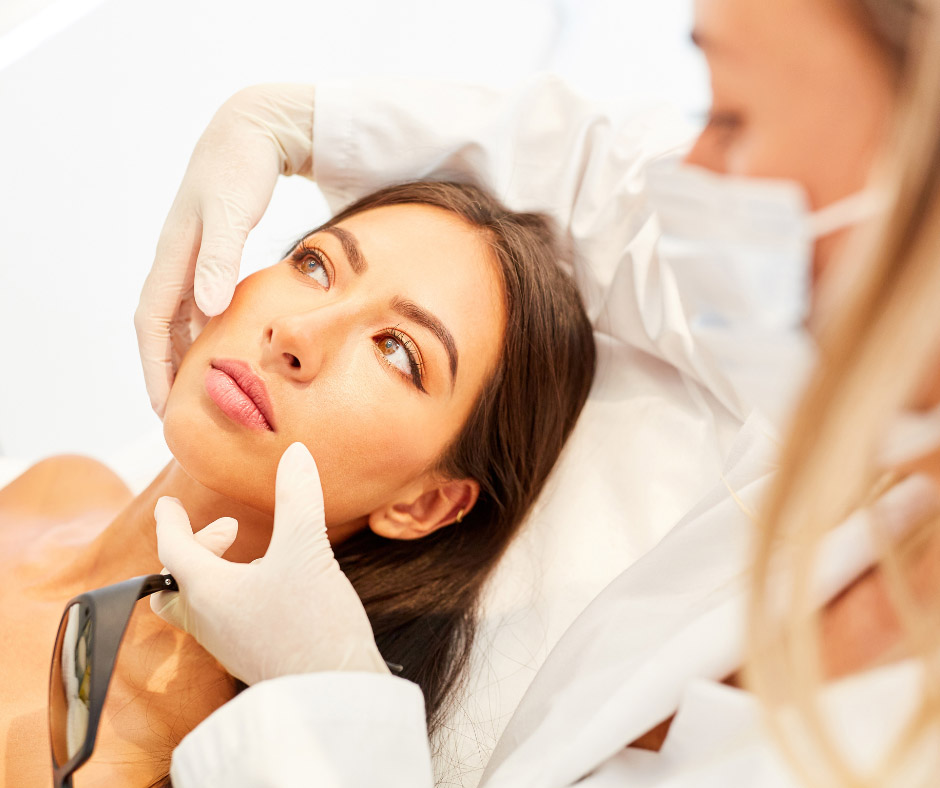 Improve Symmetry and Balance With Facial Implants
Improve Symmetry and Balance With Facial Implants
When you look in the mirror and notice facial features that seem less defined, it’s easy to feel like there’s no way to enhance your appearance. But the truth is, thanks to modern facial implant technologies for chin and cheek enhancement there is now hope.
Board-certified plastic surgeon Dr. Trang Vo-Nguyen, known as Dr. V, has earned the reputation of providing honest, accurate, and the most up-to-date information to patients considering facial implants. From her practice, The Virginia Institute for Surgical Arts, Dr. V offers a complete menu for cosmetic procedures and plastic surgery serving the Virginia area and beyond. Facial implants can aesthetically balance your facial contours and augment the areas in your face that have weakly defined tissue. Chin and cheek implants are the most commonly performed facial implant procedures although there are numerous other options depending on your situation. Conditions Facial Implants Benefit
Facial implants restore structure to areas of your face currently lacking definition or volume. It’s an ideal and safe surgery option for anyone seeking facial symmetry or angle improvements, particularly in the following areas:
Weak Chin
Chin implants are a popular and fast-growing implant type adding greater projection to a recessed chin. This implant works especially well if you’re aiming to create a stronger side and front-on profile where your chin looks stronger and more squared.Flat “Recessed” Cheeks
Cheek implants restore volume to sunken or flat facial cheeks, creating a softer, plumper, and younger mid-face.
Facial Asymmetry
Implants are personalized to correct imbalances in total facial structure, especially after events like traumatic injuries. The implants recreate natural harmony and symmetry across your own unique existing features.
Age-Related Volume Loss
Facial implants replace and support key soft tissue in areas surrounding the cheekbones and jawline. This tissue loses strength over time and makes your face appear less defined. With facial implants, you restore fullness to specific areas that directly contribute to a more youthful face.
Types of Facial Implants
Cheek Implants
The appearance of your face is determined by three basic components: your skin, soft tissues, and your underlying facial bones. Your facial skeleton determines whether your face is narrow, long, square, angulated, round, or wide and bone deficiencies are revealed in the surface of your skin.
Prominent malar bones, or high cheekbones, have always been and are currently a sign of youthfulness. Strong malar features add structural support to your overlying tissues and counteract the descent of soft tissues in your cheek and midface areas.
Cheek augmentation will eliminate the sunken appearance under your eyes or mid-facial area and enhance or restore facial proportions by correcting the point of maximal projection known as the zygomatic arch. In a narrow face, cheek implants will make the face wider by placing the implants further apart. If a patient’s face is too wide and flat, by shortening the distance between implants the face will appear more narrow and angular. The choice of your cheek implant and procedure will be discussed and chosen during your individual consultation with Dr. V.
There are three variables of cheek augmentation, including:
- Implant shape and projection
- Implant volume
- Implant position
Chin Implants
Another area that causes significant imbalance to the overall appearance of your face is your chin. The chin is the most important characteristic of your lower face and together with your nose determines facial symmetry.
A small or short chin can cause your neck to look less defined and create an illusion of having a larger nose while a prominent or long chin can make your upper face look sunken and your nose too small.
The most reliable means for assessing your chin position in relation to your chin line is with a ‘chin meridian’. This is a digital photo taken from the side of your face that transposes the line of your profile to help determine the ideal positioning of your chin and the point of optimal lower facial balance. If your chin falls behind this line, it usually means that you have Microgenia or a receding chin in the horizontal direction. Even small changes in the size of your chin can result in a very noticeable improvement in the overall balance of your face.
During your chin plant procedure, Dr. V will select the proper size and shape before inserting the soft, biocompatible implant into a pocket over the front of your jawbone. Some bruising and swelling are to be expected but these symptoms typically resolve within one week. Results can be dramatic with this type of procedure and chin augmentation is a relatively simple adjustment resulting in a high degree of patient satisfaction and speedy recovery.
Why Choose Dr. V as Your Facial Implant Specialist?

Dr. V is the founder of the Virginia Institute for Surgical Arts and a double board-certified plastic surgeon, with certifications from both The American Board of Facial Plastic and Reconstructive Surgery and The American Board of Otolaryngology/Head and Neck Surgery. She pairs an advanced clinical resume with true patient-centered care, always putting the patient’s satisfaction and best natural results first.
Choosing Dr. V for your facial implant surgery means working with a provider who:
- Specializes in natural-looking facial implants, with deep anatomical expertise.
- Provides 3D renderings for all patients to understand their own realistic and accurate before and after results.
- Carries nearly three decades of cosmetic and reconstructive procedure experience.
- Practices continued education and clinical training to stay on top of her field.
- Utilizes only the most advanced, contemporary implant materials and surgical techniques to minimize scarring, improve recovery, and ensure good outcomes.
- Cares deeply about her patients, treating each empathetically and uniquely.
- Trusted by hundreds of patients across Northern Virginia.
Read Our Patient Testimonies
See what our patients have to say about their transformative face implant results.

Overview of Facial Implant Surgery
Experience matters for any cosmetic procedure and as an expert in the field of facial plastic surgery with years of extensive training and experience, at The Virginia Institute for Surgical Arts, Dr. V will provide you with an individualized plan to achieve all of your aesthetic goals. She is a world-renowned surgeon and her goal with every patient is to achieve overall harmony and a natural, beautiful outcome that you will love for years to come. Enhancing the contours of your face with facial implants will provide a sculpted appearance and balanced profile with a permanent yet predictable result.
Implant Consultation
Meet Dr. V and your dedicated care team. We assess your facial structure — skin, soft tissues, and underlying bones and ligaments — and then discuss implant options and materials. We begin designing a custom surgical plan to achieve realistic enhanced results.
Pre-Surgery Preparation
Pre-surgery preparation is personalized but typically straightforward, following the recommended medical standards for patient safety and comfort. Patients are advised to avoid smoking and blood-thinning medications before surgery to support optimal healing and results.
Day of Surgery
Both chin or cheek implants can be performed through either an intra-oral (through the mouth) or trans-cutaneous (through the skin) incision. Typically, an intra-oral incision is preferred because this method leaves no visible scarring. During your procedure, the implants are placed within a small cavity on top of the bone known as periosteal positioning. Within two weeks, your implants will have settled into a stable position and they will provide enhanced contours non-distinguishable from your adjacent facial bones.
Follow-Up Appointment
Follow-up appointments with Dr. V and the medical team will assess the healing and health of incision areas, specifically ensuring scar visibility is decreasing and tissue repair is on track. We’ll also check implant stability, plus go over any other recovery concerns you may have.
Social Readiness
The vast majority of patients who receive face implant surgery resume normal activities within 1-2 weeks after their procedure. This allows time for any pain and swelling to subside, implants to securely fit into their new home, and for regular motor functions around incision areas in the mouth or jawline to heal.
Ideal Candidates for Facial Implants

Facial implants are ideal for a wide range of adults who are in good health and can undergo surgery and anesthesia. Those looking to make permanent contours or add healthier definition and structure to specific areas of their face can safely turn to face implants.
Overall, consider the following if you’re interested in face implants:
- You’re an adult in good overall health.
- You experience noticeable facial asymmetry.
- You have significant facial volume loss due to aging.
- You are a non-smoker or willing to stop smoking leading up to surgery.
- You desire long-term, lasting results over repeat filler injections.
- You have realistic expectations for results.
What to Expect During Implant Recovery
Face implant recovery, including for cheek implants or chin implants, is typically straightforward.
- Swelling and bruising at incision sites are common, lasting 1-2 weeks.
- Minor pain and tenderness in areas where implants have been added.
- Suture dissolvement or removal within 7-10 days.
- Prioritize eating soft foods, which is especially recommended for intraoral incisions.
- Avoid strenuous activities and heavy exercise for 2-4 weeks post-surgery.
- Full results are typically visible once swelling has receded, usually in full at the 4-6 week mark.
All patients must ensure they’re following post-op care instructions. These instructions are tailored to you, including aftercare detailed around your specific surgery incisions, implant types, skin, age, lifestyle, any health conditions, and more.
Benefits of Getting Face Implants
- One permanent solution for facial contouring that doesn’t require repeat procedures.
- Improves facial symmetry and balance without looking unnatural.
- Restores tissue volume due to aging or traumatic injuries.
- Customized implant shapes, sizes, and biosafe materials.
- Potentially scar-free surgery, if you undergo intra-oral surgical incisions.
- Short recovery timelines averaging just a few weeks (~2 weeks on average; with results appearing in full shortly after).
- Shapes that look natural and complementary to your existing features.
Risks of Facial Implant Surgery
Surgery side effects are rare, particularly when you receive implants from a well-accredited facial plastic surgeon, like Dr. V and the medical specialists at Virginia Institute for Surgical Arts.
It’s important to undergo your facial implant surgery, or any surgery, understanding your possible risks.
- Infection, though minimal with proper aftercare.
- Implant shifting, which can require minor revision surgery to prevent asymmetry.
- Temporary swelling or numbness lasting 1-2 weeks.
- Potential visible scars if external incisions were required.
Combine Face Implants and Other Cosmetic Enhancements
Dr. V and the Virginia Institute for Surgical Arts are proud to offer a portfolio of cosmetic procedures that improve the appearance of your face long-term, both via surgical and non-surgical options.Rhinoplasty
Refine the nose shape to complement chin or cheek implants for enhanced facial harmony and improved proportions.
Neck Lift
Tighten sagging skin and redefine the jawline for a smoother, more sculpted lower face and neck that can reduce the appearance of double chins, turkey neck, and more.
Facial Fat Transfers
Restore soft tissue volume directly to the cheeks, creating an ultra-natural, healthy lift to your face and combatting prominent age-related lines and sagging.
Injectables
A wide range of facial fillers provide plumpness and recountering, for when surgery isn’t your top choice.
Book a Consultation
Take your first step in having the naturally balanced, more symmetrical face you’ve always wanted.
Dr. V and the medical specialists at Virginia Institute for Surgical Arts are here to consult with you at every step, from reviewing possible implant types and locations, to creating custom 3D renders, through your safe procedure and aftercare.
Read More About Facial Implants
Discover more about facial implant surgery with our blog resources.
Facial Implant FAQ
Facial implants are tailored to each individual and may be small, moderate, or large in scale. Chin and cheek implants are manufactured using a variety of materials such as high-strength silicone, nylon mesh, high-density polyethylene, hydroxyapatite compounds, and other substances. At The Virginia Institute, implant size, material, and shape are tailored to your facial form and desired outcome and the technique used to insert your facial implant will depend on the area where the implant will be positioned.
Written by Dr. V.
Dr. Trang Vo-Nguyen (“Dr. V”) is a board-certified facial plastic surgeon specializing in advanced cosmetic and reconstructive facial procedures in Northern Virginia.



